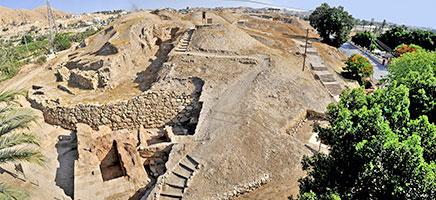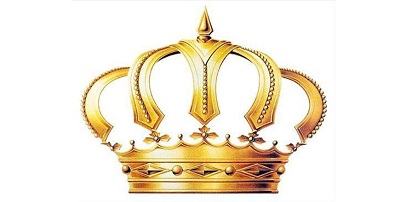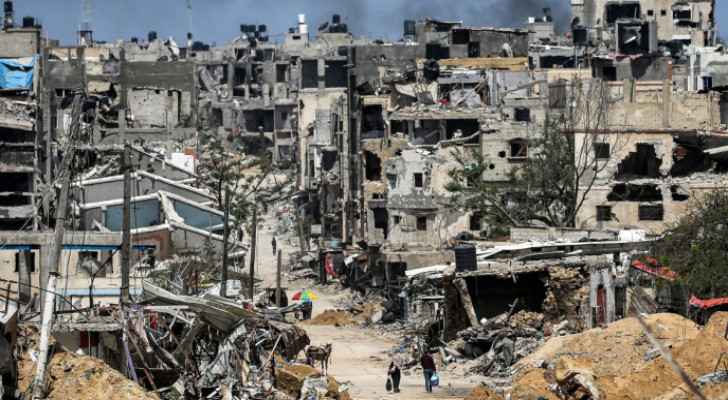Site in Jericho offers clues into burial rites of ancient world

By Saeb Rawashdeh , The Jordan Times
AMMAN — The transition in burial practice and rites during different phases of the Bronze Age intrigued researchers studying the ancient site of Jericho, they recently told The Jordan Times.
Jericho contains skeletal assemblages that represent fractions of past populations from most of the different archaeological periods covering a time span from 3,500 to 586 BC, said Senior Fellow at the Research Centre for Anatolian Civilisations of Koҫ University in Istanbul Rula Nuri Shafiq.
“The collection is composed of isolated crania [skull], dentition and almost complete individuals with postcranial remains,” Shafiq continued, adding that this kind of variable skeletal representation presents a good reflection of the mortuary practices found at Jericho during the different archaeological periods.
The Jericho site is divided into two parts: Tell Es-Sultan, which represents the city-settlement itself, and the associated large cemetery that contains numerous shaft burials cut directly into limestone.
“Most of the tombs are located under housing constructions at a Palestinian refugee camp, which caused some difficulties and limitations during an excavation by Kathleen Kenyon [1906-1978] in the 1950s,” she said.
The cemetery consists of a large number of tombs, all carved into the rock, the archaeologist elaborated, adding that the tombs are made of two parts,” the shaft and burial chamber, which both vary in size between the different archaeological periods”.
“The tomb structure usually has a vertical shaft entrance with rounded edges and a depth that varies between one to two metres. The maximum size of shaft reported by Kenyon [1957] was 4.8 metres long and 3 metres wide, with a chamber 4.5 metres in diameter,” Shafiq outlined.
After the burials were completed, the chamber was blocked by rocks, and the shafts were filled with rubble that came from carving the tombs, the scholar explained, adding that most of the periods represented at Jericho were characterised by communal burials, with the exception of the Early Bronze IV period, which was distinguished by single interments.
"Kenyon reported that the burial practices consisted of two phases: first, the deceased would be placed at the central part of the chamber with their burial goods; second, after some time, the disarticulated skeletons were removed to allow room for new interments. The skulls were collected and placed around the chamber walls, while the postcranial bones were discarded outside the tomb. Analysis of the skeletal remains showed clear evidence of cremation that was conducted inside the tombs," Shafiq said.
Tombs dating to the Early Bronze II-III periods were partly damaged by the collapse of the roofs of the burial chambers, thus affecting the preservation of the skeletal remains, the researcher said, stressing that most of the remains were represented by only skulls and a few mixed piles of long bones.
“The Early Bronze IV period showed a striking difference in the burial practices from the preceding Early Bronze II-III and the following Middle Bronze. Early Bronze IV is the only period characterised by single interment burials. There are a few cases of double burials, but the majority are single with much smaller burial chambers than the other periods." Shafiq elaborated.
Furthermore, several of the Early Bronze IV burials are primary but the majority are secondary as indicated by the disarticulated skeletons. Burial goods are simple with a few pots, a dagger, some beads and the remains of animal bones.
Tombs dating to the Middle Bronze II-III periods are mostly re-used Early Bronze IV burial chambers, with only a few tombs of Middle Bronze origin, the scholar said, noting that Kenyon in 1960 reported that the majority of the preserved Middle Bronze tombs showed primary articulated burials.
All Middle Bronze tombs exhibited richer burial goods and more elaborate body treatments compared to the other periods, she highlighted, saying: "Several of the tombs had the remains of wooden objects such as tables, stools, cups and bowls. There were also the remains of sheep and goat bones placed in pots evidently cooked before being placed into the tombs; and parts of these animal bones were found in full articulation with the desiccated meat still preserved. There were also remains of fruits such as pomegranates and possibly grapes [Kenyon 1960]."
"Certain tombs showed special burial treatments for certain individuals, which might be interpreted as ‘elite burials’; Several tombs showed the body of a main individual being placed on a wooden bed or a raised platform, while the remaining interments were placed just below the platform," she emphasised.
"Generally, weapons were not a frequent find in any of these archaeological periods, with the only exception — the Early Bronze IV period — that had the highest number of weapons in the form of daggers [Kenyon 1957]," Shafiq said.
Latest News
 King orders holding parliamentary elections in accordance with law, checks on electoral commission’s preparations
King orders holding parliamentary elections in accordance with law, checks on electoral commission’s preparations- N. Macedonia starts elections that could decide stalled EU talks
 US Senate passes bill for aid to Israeli Occupation, Ukraine, Taiwan
US Senate passes bill for aid to Israeli Occupation, Ukraine, Taiwan Safadi discusses support to Syrian refugee with DRC
Safadi discusses support to Syrian refugee with DRC Israeli Occupation aggression on Gaza enters 200th day
Israeli Occupation aggression on Gaza enters 200th day
Most Read Articles
- US president signs bill to provide new aid for Ukraine
- Prime minister directs government to support IEC ahead of upcoming elections
- Palestinian prime minister, Jordanian ambassador discuss humanitarian efforts in Palestine
- Iran cuts Syria presence after strikes blamed on Israel —monitor
- US Supreme Court seems split on Idaho abortion ban
- UAE announces $544m for repairs after record rains
- Germany nudges up growth forecast, ailing economy at 'turning point'
- Four dead as floods wreak havoc in Kenyan capital
- Vaccines saved at least 154 million lives in 50 years — WHO
- Israel pummels Gaza after US Congress approves military aid